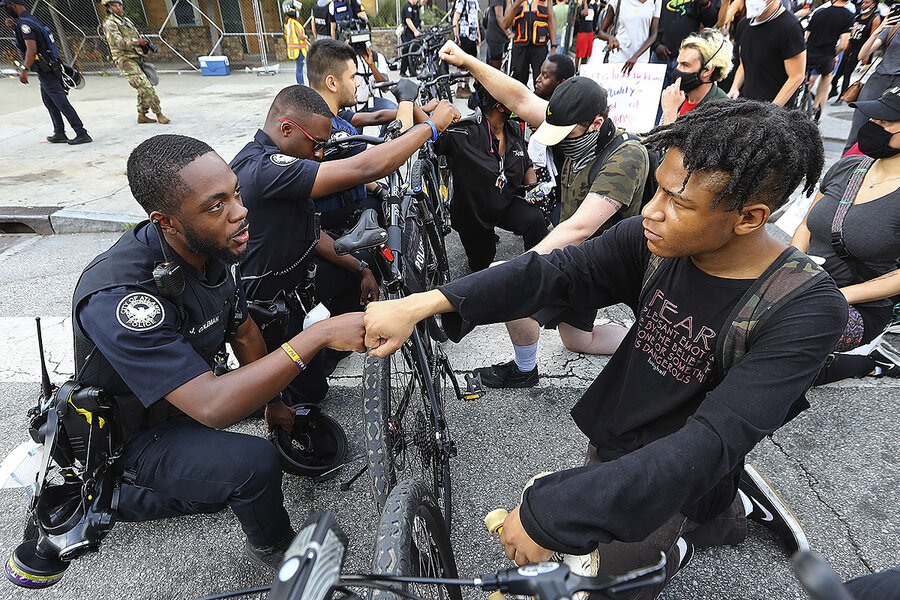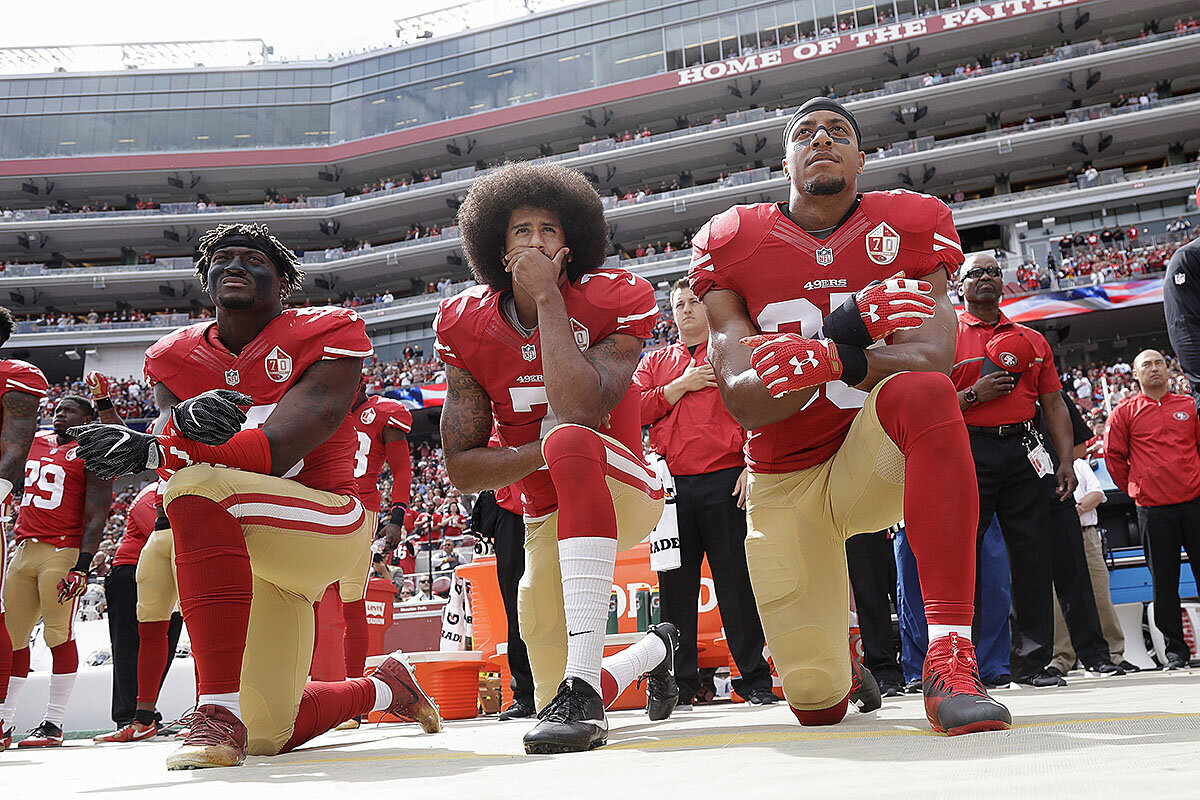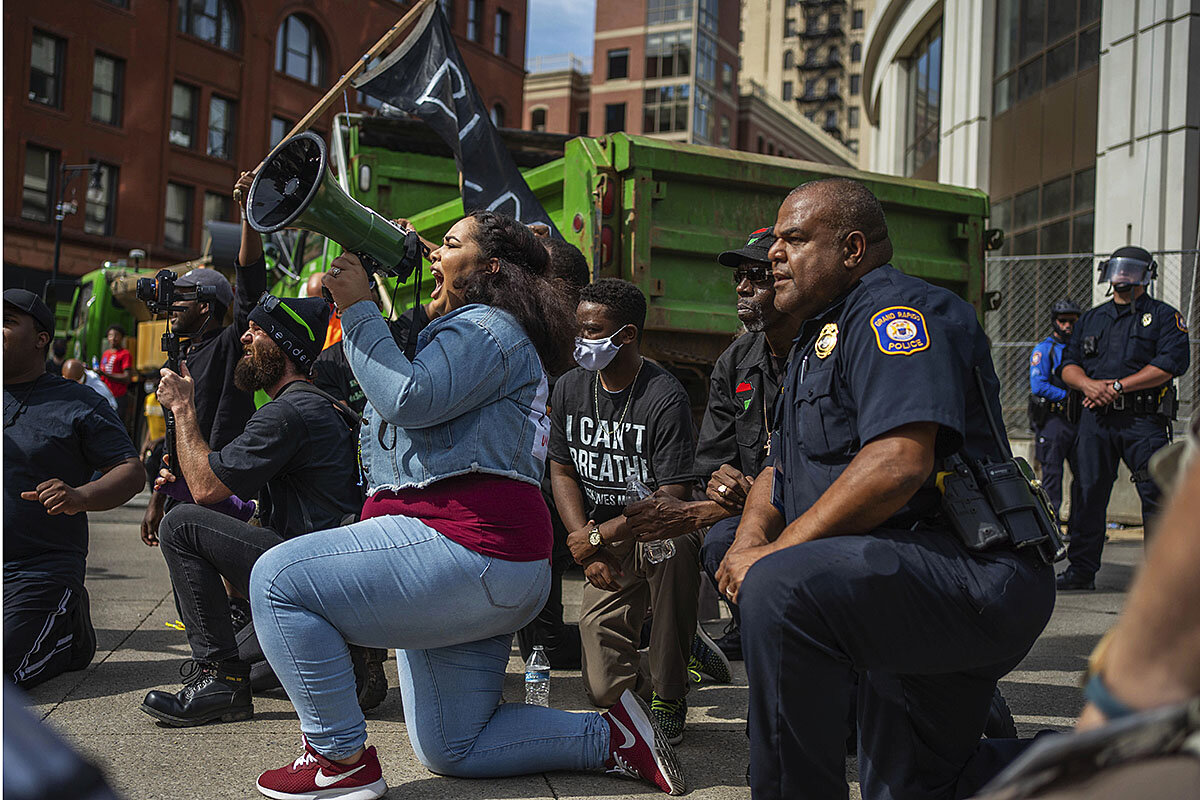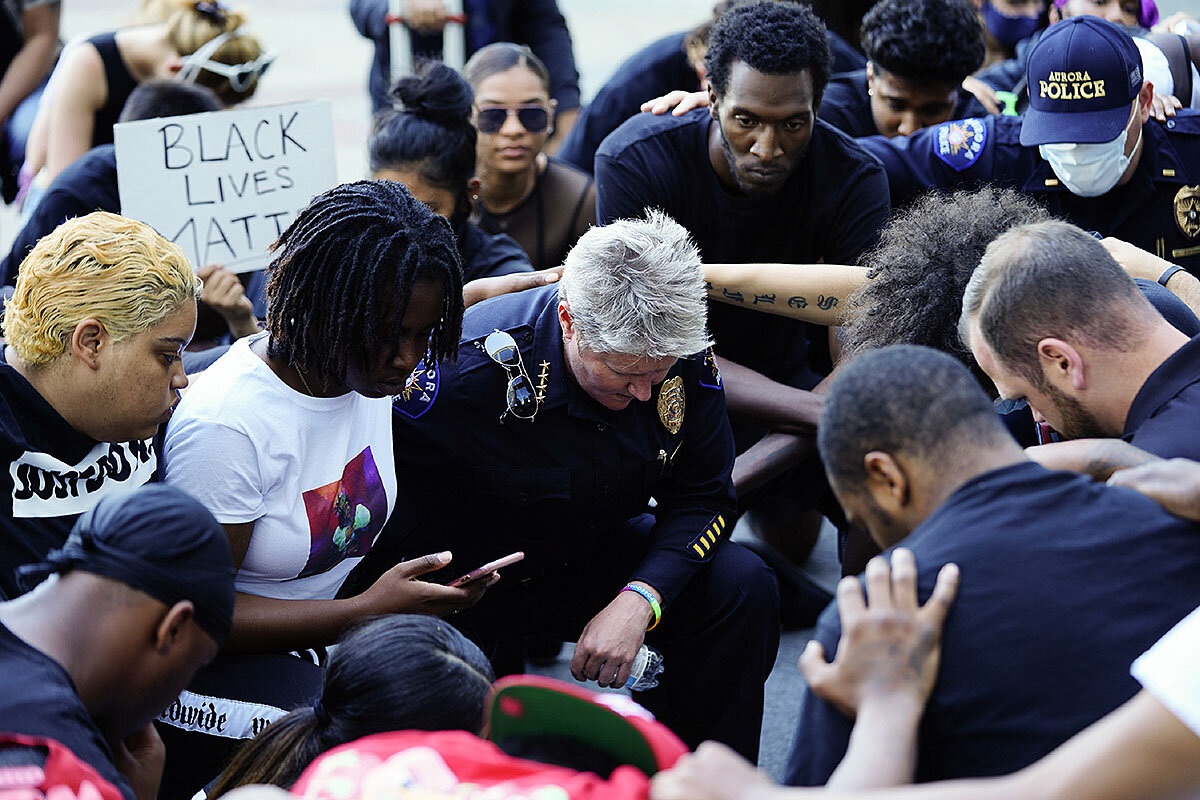The promise – and limits – of police taking a knee
Loading...
| New York
This Sunday, many protesters were startled by NYPD officers in an intersection in Queens.
Led by the commanding officer, kneeling officers were cheered with cries of “thank you” by protesters who formed a circle around them.
Why We Wrote This
What does it mean to kneel? Officers taking a knee in the wake of George Floyd’s killing in police custody mark a powerful change in tone after the controversy over Colin Kaepernick’s career-ending protest.
Similar gestures have been occurring in cities across the United States. Often dressed in riot gear, groups of police in Portland, Oregon; Santa Cruz, California; El Paso, Texas; and Flint, Michigan, have collectively taken a knee.
The poignance of these images are not simply counterpoints to the rage sweeping across the country. For many who have watched efforts to address the long and troubling history of racial inequities in American law enforcement, the symbolic gesture of police officers taking a knee is a positive sign. But for others, it’s just the beginning.
“I know they were flipping it, yes, taking a knee to show peace and honor and humility – and that’s right, that’s a good thing,” says Veronica Bell, mother of Sean Bell, who was killed by police the day before his wedding in 2006. “But that’s not all that matters.”
“I might not see the change while I’m living,” she says, “but I pray that my children and my grandchildren will help make that change for the country they will have to rebuild.”
Valerie Bell had mixed reactions this week when she watched police officers across the country take a knee as they confronted crowds of people protesting the killing of George Floyd.
There was a part of her that was grateful, especially since their actions seemed to be a much-belated acknowledgement of former quarterback Colin Kaepernick, who knelt as a symbol of solidarity with Black Lives Matter during game-day performances of the national anthem, enduring widespread criticism. He has since been shunned by the NFL.
“Most of them, they were against [Kaepernick] doing that, and I felt that was wrong,” says Ms. Bell, who is among an organized group of mothers whose sons are part of the ever-growing roll call of black men killed by police. “That was what he chose to do to show honor to those who were killed by police officers. And by the cops kneeling today, to me, I guess they’re trying to do what he did. I guess by kneeling they are at least trying to show a peaceful sign to the protesters.”
Why We Wrote This
What does it mean to kneel? Officers taking a knee in the wake of George Floyd’s killing in police custody mark a powerful change in tone after the controversy over Colin Kaepernick’s career-ending protest.
Her own son, Sean Bell, was shot and killed by New York City plainclothes cops in 2006, in the early morning hours before his wedding. During his bachelor party, undercover officers said they saw a gun in his vehicle, and opened fire with a hail of 50 bullets. No weapon was found. Three officers were tried and acquitted of manslaughter.
Ms. Bell is part of an organized group of mothers with the Justice Committee, which includes Gwen Carr, the mother of Eric Garner; Constance Malcolm, the mother of Ramarley Graham; Herencia Petersen, aunt of Akai Gurley; as well as more than a dozen others who have formed a bond, she says, as the names of their sons continue to be chanted during protests.
“But when you see these officers take a knee, you also think, ‘Oh my God, the cop who killed George Floyd kneeled like that on this poor man’s neck’ – and he was a strong man, and all he could do, I mean, he was just crying out for his mother,” Ms. Bell says. “It’s not a good feeling; it’s like opening up a wound all over again.”
She pauses and then says, softly, “I mean, 50 shots. Fifty shots.”
“I know they were flipping it, yes, taking a knee to show peace and honor and humility – and that’s right, that’s a good thing,” she continues. “But that’s not all that matters.”
For the past few months, Ms. Bell, Ms. Carr, Ms. Malcolm, and 15 other mothers have been working to demand the repeal of New York’s “police secrecy law,” which keeps all disciplinary records out of public view.
Even as Ms. Bell and other activists feel ambivalent about watching police officers take a symbolic knee in the presence of those protesting the killing of George Floyd, those gestures mark a powerful change in tone after the angry controversy over Mr. Kaepernick’s career-ending protest.
This Sunday in New York, many protesters were startled by NYPD officers kneeling – apparently in solidarity with them – in the middle of an intersection in Queens.
Led by the commanding officer of the precinct, Deputy Inspector Vincent Tavalaro, the group of officers was cheered with cries of “thank you” by protesters who formed a circle around them, and captured in photos and videos on social media. “Keep that knee!” many began to chant after the officers stood up. So, they took a knee again.
“We need more of this, to see and hear each other, to work together, to recognize that our differences are our strength,” tweeted NYPD Commissioner Dermot Shae, including a photo of Commander Tavalaro embracing protesters.
On Monday, a group of more than 60 police officers in Fayetteville, North Carolina, dressed in riot gear, defused a tense confrontation with protesters by taking a knee as a group approached them just before the city’s 8 p.m. curfew.
Instead of tear gas and physical confrontations, there were tears, and even embraces, between Fayetteville police and many protesters, witnesses say.
“The protesters first got mad when asked to step back, but once the officers knelt down, it was on,” commented Mimamo Monika on the Fayetteville Police Department’s Facebook page. “Men and women alike started crying and then cautiously came toward the police officers to shake their hands.”
“The protesters thought they were going to be arrested, but our Fayetteville PD humbly knelt before them instead,” the commenter continued. “These are moments that will go down into history and will be taught to future generations.”
Similar gestures of humility and respect between police officers and protesters have been occurring in cities across the U.S. Often dressed in full riot gear, groups of police in Portland, Oregon; Santa Cruz, California; Coral Gables, Florida; El Paso, Texas; and Flint, Michigan, have collectively taken a knee to offer a gesture of solidarity, acts that have mostly diffused tension and drawn cheers.
The poignance of these images have been peaceful counterpoints to the rage sweeping across the country. Bands have looted and vandalized buildings, and there have been instances of police officers being attacked.
But in other cities, police have beaten, gassed, and targeted protesters and journalists with rubber bullets. And sometimes, the very police department whose officers knelt with protesters have then been abusive. On Wednesday, Buffalo Police Department officers, too, knelt before protesters, drawing cheers. The next day, however, at the same spot they had kneeled, Buffalo officers shoved an elderly man to the ground and walked over him as he lay bleeding on the sidewalk. Two officers involved were immediately suspended, the department said.
But for many who have watched efforts to address the long and troubling history of racial inequities in American law enforcement, the symbolic gesture of police officers taking a knee as protesters march against the killing of George Floyd in police custody is a positive sign.
“I think the image of police officers kneeling is so very powerful, given how Colin Kaepernick made that gesture the preeminent symbol of protest against police killings of unarmed black people,” says Mark Naison, professor of African American studies and history at Fordham University in New York.
“Seeing police officers, some of whom are white, take a knee to protest the death of George Floyd is even more significant because the only way to get rid of racists and white supremacists and serial abusers on police forces is for their fellow officers to expose them and demand they be removed,” he says.
As many officers embrace the act of kneeling, some people are reevaluating their feelings about the protests of Mr. Kaepernick.
“It is interesting to note that Kaepernick started his protests by sitting during the national anthem, but after discussion with a veteran who was offended by his actions, he switched to kneeling because it was more respectful,” says Jennifer Lambe, professor of communication at the University of Delaware.
“Police officers kneeling alongside protesters has been a welcome start to many, signifying hope that a new way of communicating about police brutality is possible,” she says.
In fact, there is an inherent dignity in the act of kneeling throughout history, many scholars say, and it has long been an essential act of humility and respect in the spheres of religion and politics.
“When we kneel, we recognize that we are before someone or something that is greater than we are,” says Linda Seger, a Quaker scholar and author of “Jesus Rode a Donkey,” which explores the intersection of religion and liberal politics.
“Sometimes that something is evil, and we are forced to our knees before what is dark and overpowering,” Dr. Seger continues. “But in most cases, taking a knee is a sign of chosen humility. We realize we are vulnerable, and we even accept it. We kneel in the hope that we can be renewed and cleansed and forgiven, and with the hope that a wrong will be recognized and righted, and that goodness will ultimately be victorious.”
For Ms. Bell and others, however, the image of the Minneapolis police officer kneeling on Mr. Floyd’s neck, even as he lay prostrate, bound, and crying out for his mother, should remain the focus.
No matter how many police officers make this gesture, she says, there can be no victory for goodness or any lasting change until significant structural changes in America’s law enforcement systems take hold.
“They talk about the training, the training, the training,” she says. “But what type of training are you doing with these police officers, when this happens again and again? There has to be accountability and transparency – and the good ones do need to speak out about the bad ones, because now they don’t because of the ‘blue wall of silence.’”
Nearly 15 years after her son Sean was shot and killed by police, this month has been particularly poignant. Her son’s two daughters are both graduating – the youngest was five months old when he was killed, and she’s now finishing junior high. His oldest is graduating from high school and plans to attend law school.
“We have to stay on the politicians’ back, just like we are now in New York,” Ms. Bell says. “I hope and pray they will come to a sense that to make this change, we have to do something different. Like I tell everybody, I might not see the change while I’m living, but I pray that my children and my grandchildren will help make that change for the country they will have to rebuild.”
Editor's note: This story has been updated to correct dates.











